How to Protect Your Diamond from Chipping
May 5, 2016
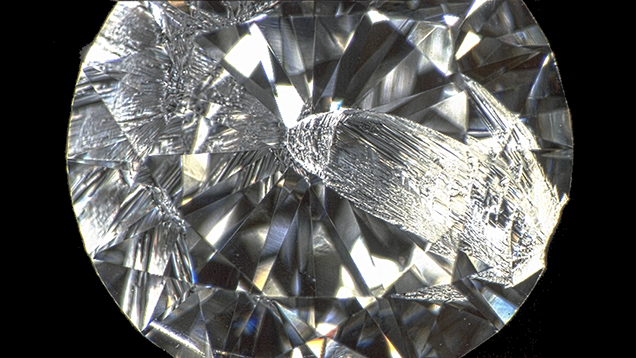
DIAMOND DURABILITY
Gems are valued for their beauty, rarity, and durability. Durability is a gemstone’s ability to withstand wear, heat, and chemicals. The concept of durability consists of three properties:
- Hardness: How well a gemstone resists scratches and abrasion
- Toughness: How well a gemstone resists breaking and chipping
- Stability: How well a gemstone resists chemicals and thermal shock
Diamond is very stable and extremely hard, but only somewhat tough. The hardness is uneven along different directions of the crystal, and this has important implications both for the cutting process and the durability of diamonds cut in various shapes.
Hardness
The hardness of a diamond is a result of its very compact crystal structure. “Diamond has an indentation or scratch hardness five times that of carbides. [Figure 1] illustrates the hardness of diamond compared to other materials according to both Moh’s [sic] and Knoop’s hardness scales. However, diamond is relatively brittle and will chip or fracture if it is not handled and protected against shock” (V.C. Venkatesh and S. Izman, Precision Engineering, 2007, p. 50). Diamond is the hardest known natural mineral on both the Mohs and Knoop scales, which characterize a mineral’s scratch resistance through the ability of a harder material to scratch a softer material.
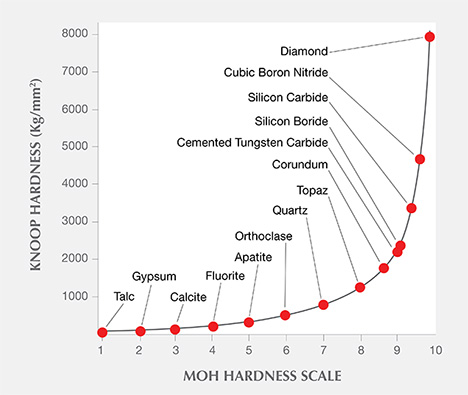
micro-hardness test where a pyramidal diamond point is pressed into the polished
surface of the sample with a known load for a specified time and the resulting indentation
is measured with a microscope. Illustration modified from V.C. Venkatesh and S. Izman,
Precision Engineering, 2007, p. 50.
Stability
Diamonds are very stable and invulnerable to virtually all acids. They can also withstand higher temperatures than most gemstones. Sudden extreme temperature changes can cause damage, however.
Toughness
Diamonds can chip or fracture from hard impact, especially in areas where the carbon atoms are not tightly bonded. These areas, called cleavage planes, are the major source of damage to diamonds (figure 2). The toughness scale used in scientific literature is called a fracture toughness scale, but it is rarely mentioned in gemology. The toughness scale measures (in erg/cm2) the work required to separate two surfaces of a crystal along a certain crystallographic plane. Values for diamond generally range from 5,000 (along the cleavage planes) to over 8,000 (in the “hardest” direction). Compare those values to 225,000 for nephrite and 120,000 for jadeite, which are tougher, and 600 for corundum, which is not as tough.
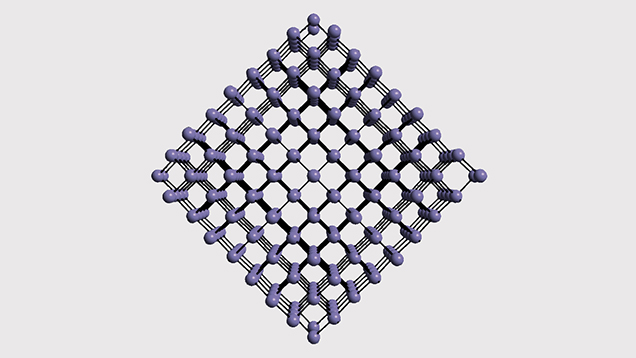
TOUGHNESS: THE ACHILLES HEEL OF DIAMOND
Even though diamond is the hardest natural material, it can chip and fracture in the course of normal wear. Diamond is formed in the cubic crystal system and has four perfect cleavage directions. A cleavage plane is the weakest direction in the molecular arrangement of the crystal. Diamonds are tougher in the directions where the atoms are bonded tightly together, less tough where they’re not so tightly bonded. The most common form of the natural diamond crystal is an octahedron (figure 3), and our focus will be on that typical shape. Cleaving is the splitting of a diamond crystal parallel to one of its triangular, octahedral planes. While not the perfect example, compare wood, which has a single grain typically split by an axe with ease. A natural diamond crystal can only be cleaved parallel to one of the triangular octahedral faces (figure 4).
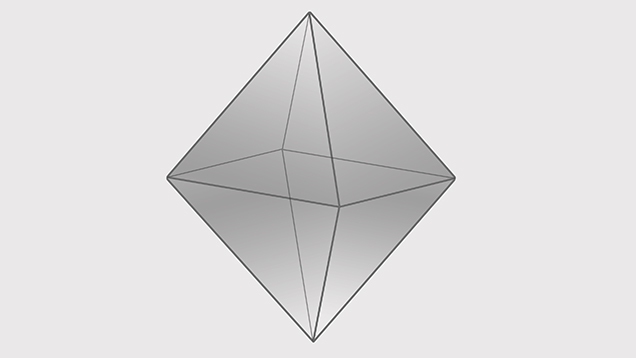
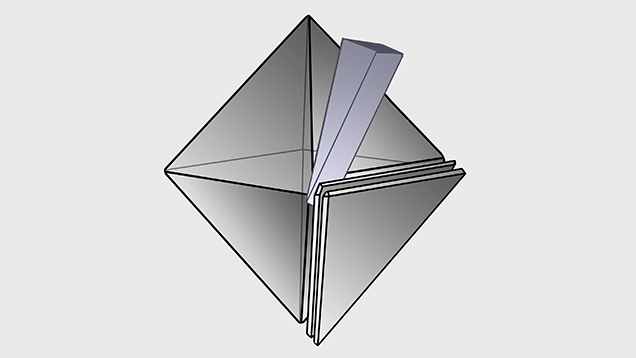
Because diamonds are harder and tougher along certain directions of the octahedral crystal, they are also more resistant to chipping, abrasion, or cutting with other diamonds along these directions (figure 5). There are also softer directions (figure 6). For some of the famous historical diamonds, months were spent planning before cleaving because the external partial crystal form obscured the octahedral directions.
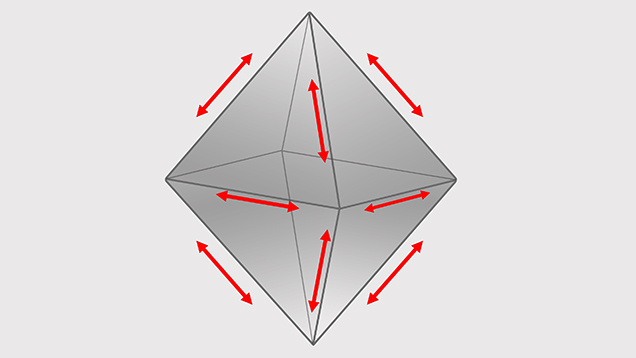
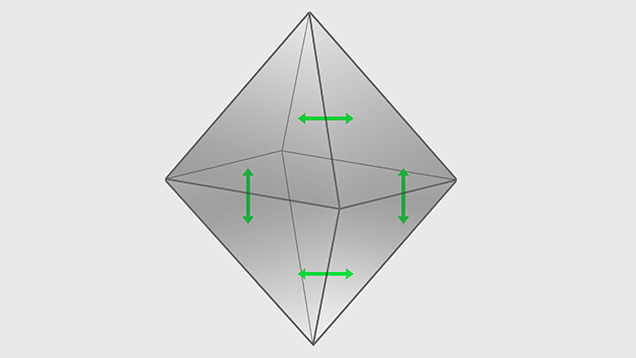
Diamonds are rarely cleaved today. Usually they are sawn and, more recently, cut by laser. However, cutters still need to understand the hard and easy directions of polishing as well as the location of cleavage planes in order to plan cutting. An octahedron generally yields a round brilliant from a certain location within the crystal (figure 7).
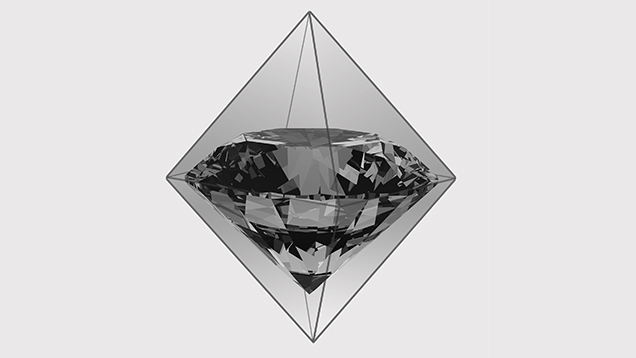
During the planning stage, a saw is used to cut off the top portion, which can be used to cut another diamond. Note that the typical crown (top) of a round brilliant is slightly higher than the typical crown of a princess cut. If the cutter wants to create two princess-cut diamonds from a crystal, the planning is slightly different than when two rounds are being cut (figure 8).
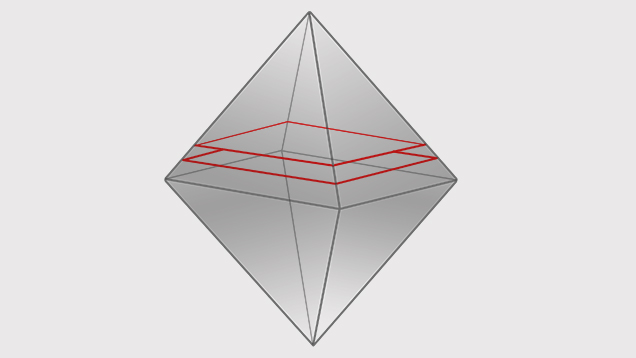
Remember that diamonds are tougher in the directions where the atoms are bonded tightly together, less tough where they’re not so tightly bonded. Look at the location of the corners on a princess cut, which are very vulnerable to chipping since they lie close to the cleavage plane. Cutting styles like these, with pointed corners or ends, are often set with prongs to protect the corners from chipping. Even still, a hard blow to a prong at a corner of a princess cut (figure 9) can cause a chip to run down the side of the diamond. This is not exactly at the cleavage plane, where the carbon atoms are farthest apart, but very near it. When chips occur, they rarely look like smooth flat planes of cleavage. Rather, they appear to be stepped, because they are not directly on the cleavage plane (figures 10 and 11).
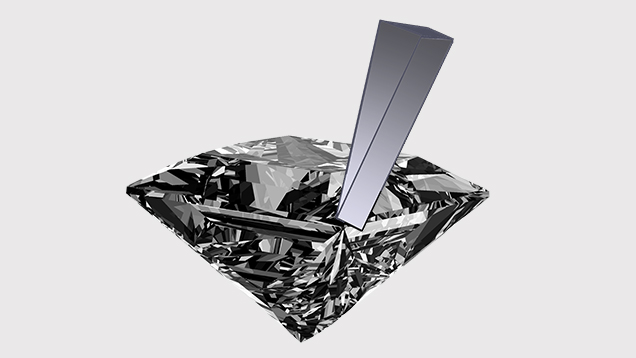
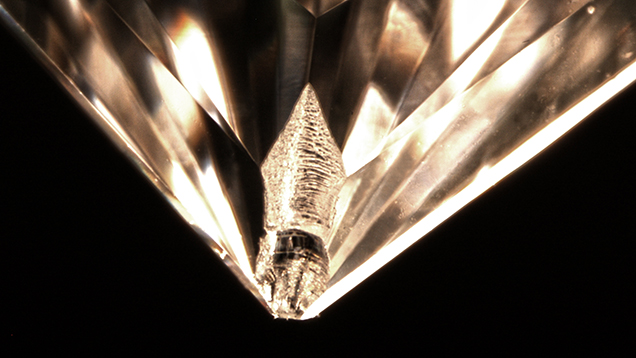
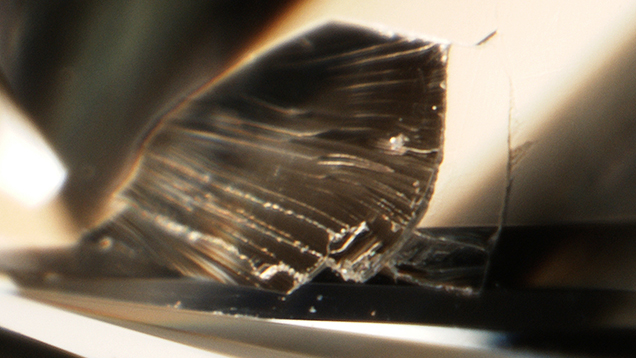
HOW TO MINIMIZE THE RISK OF DIAMOND CHIPPING
Chips typically occur when the girdle (edge) or point of a diamond strikes something hard. Bathroom and kitchen countertops, as well as jewelry items with diamonds worn next to each other, are common causes of chips.
1. Avoid shapes with points or sharp corners
Any shape of diamond with points or sharp corners is more exposed to chipping at those locations (figures 11 and 12). Round, oval, and rounded-corner cushions don’t have that point exposure. A more recent cutting technique called chamfering is used by some in the diamond trade and believed to improve durability for princess cuts. Chamfering places a very small flat facet on the corners (figure 13).


2. Protect the culet
At one time, almost all standard round brilliant cut diamonds and many other shapes were cut with a small facet at the culet. This was to protect the culet from chipping. Now most diamonds come to a sharp point at the culet, and thus all culets with points are vulnerable (figure 14). Once they are set in jewelry, however, there is little risk of damaging the culet.
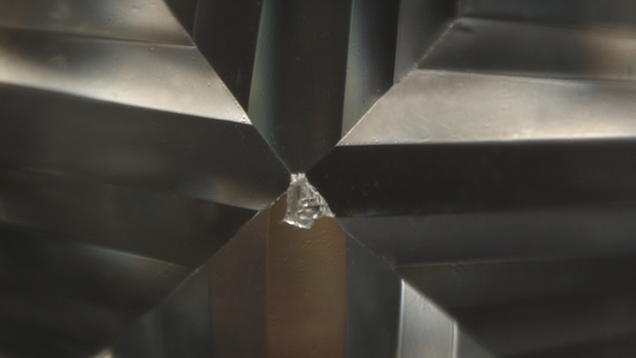
3. Avoid girdles with very thin sections
While a strong blow can break a diamond at the girdle, a thicker girdle is more difficult to chip. Girdles with very thin places along the sides or at the corners and points are at a much higher risk of damage (figures 15 and 16).
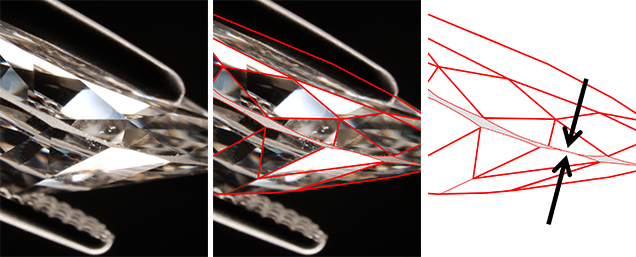

4. Chose a setting that protects the diamond
Vulnerable points or corners are better protected with bezels, partial bezels, or V-shaped prongs.
5. Use caution with tension settings
A tension setting holds a diamond in place using a groove cut into the metal that the girdle fits into, and the two ends of the ring press tightly against the diamond’s sides. A jeweler with experience in tension settings will be very careful about the condition of the girdle before allowing a diamond to be set in this manner.
The mounting is already exerting pressure on the diamond at two opposing locations on the girdle. Hitting the side of the ring puts even more stress on the girdle. This style also leaves the exposed sides of a diamond vulnerable to damage just during casual wear.
6. Regularly inspect prongs for damage
A very common cause of chipping is that the prongs holding the gem in place in a piece of jewelry become bent or broken. If a diamond is loose in the mounting, it is at higher risk of getting chipped. Prongs protect their corners, points, and sides. If the prongs become bent or broken due to wear and tear, they are not doing their job: protecting your diamond.
Even if only one prong is damaged, your diamond is no longer held securely in its mounting.
7. Don’t wear a diamond that has already chipped
If a diamond already has a chip, some think they can take care of the mounting later. That knife-edged portion of the diamond that is chipped has an extremely high risk of getting chipped far worse. Stop wearing it until you can have it repaired.
8. Be careful with inclusions near the girdle
It’s rather obvious that a diamond with many inclusions located near the girdle and/or points is rendered more prone to chipping or breaking. But sometimes there can be a small feather or other small inclusion near the girdle or point that also makes the diamond vulnerable (figures 17 and 18). If the stone is hit precisely on a feather or inclusion near the direction of a cleavage plane or at a point, a chip is likely to occur. Open cavities at the girdle are much like chips and are more easily damaged (figure 19).
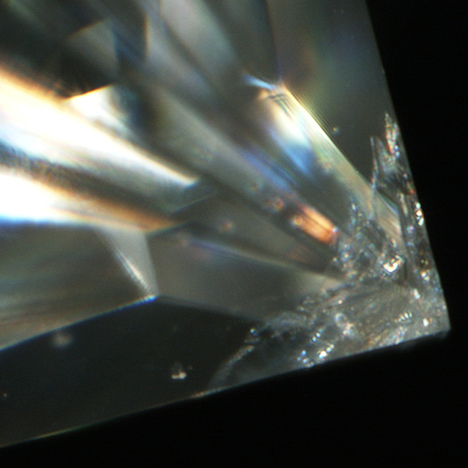
for damage when setting the diamond or when it is being worn. Photo by Mitch Lam, © GIA.
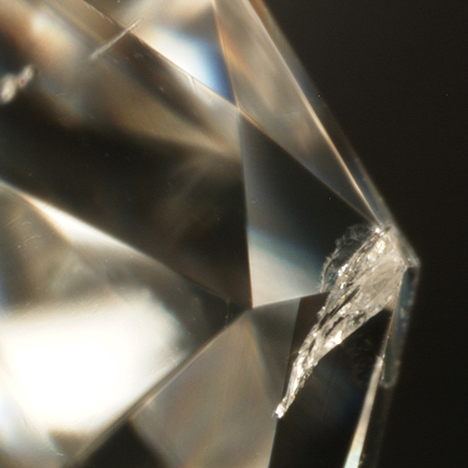
damage. Photo by Mitch Lam, © GIA.
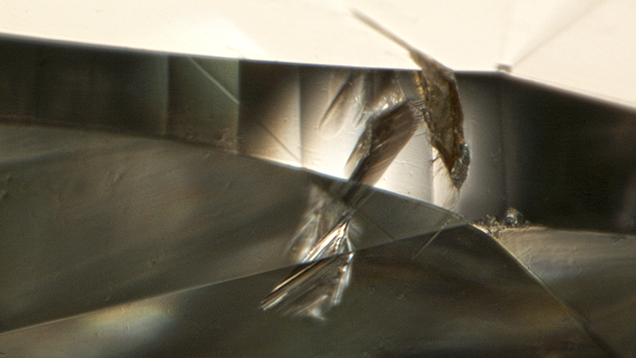
There is no such thing as perfect toughness. Any gem will break, not just chip, if it is hit hard enough. Diamonds are very tough, but remember that if a cutter can purposely cleave (split) a diamond by giving it a sharp blow in the right direction, you can achieve the same thing if you hit it hard enough accidentally. You are more likely to damage a diamond at the girdle or at a point. Diamonds with exceptionally thin places on their girdles are very vulnerable. To avoid damage, you should only wear your diamond jewelry during activities where you are unlikely to hit them hard against solid objects.



